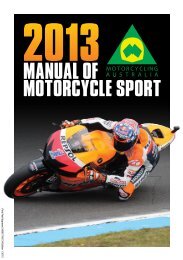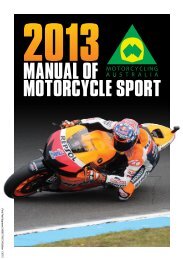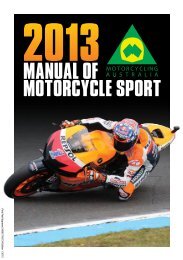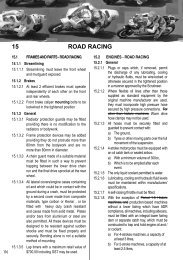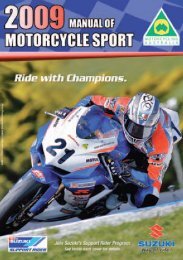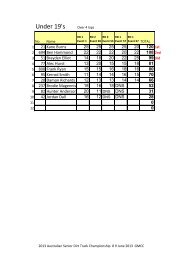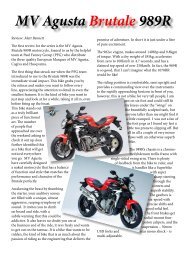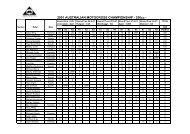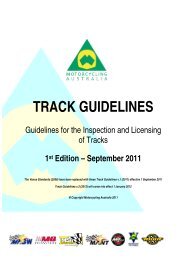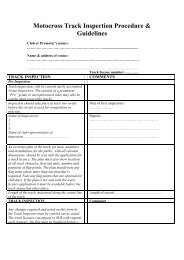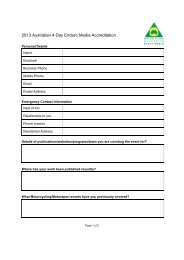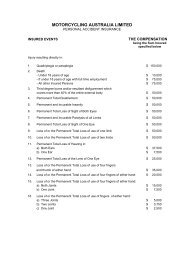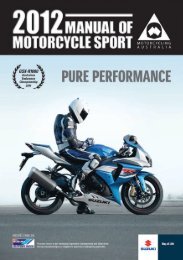2008 Manual of Motorcycle Sport - Motorcycling Australia
2008 Manual of Motorcycle Sport - Motorcycling Australia
2008 Manual of Motorcycle Sport - Motorcycling Australia
You also want an ePaper? Increase the reach of your titles
YUMPU automatically turns print PDFs into web optimized ePapers that Google loves.
hear anyone else. If you<br />
can’t hear any other bikes,<br />
go back to the last known<br />
Corner Man position and<br />
wait there, regardless <strong>of</strong><br />
the duration, as this will be<br />
a location where searchers<br />
will look for you.<br />
on-road riding<br />
MA<br />
member<br />
organisations and affiliates run a huge range <strong>of</strong><br />
events which you can take part in. These events<br />
can be as simple as a morning ride with mates or<br />
as complex as a ten day fully-catered tour. With so<br />
many events across the country, the chances are<br />
you’ll find at something to suit within easy riding<br />
distance. Check out the links to the various tours,<br />
rides, and rallies on the MA website www.ma.org.<br />
au<br />
group road riding<br />
There’s nothing quite like the feeling <strong>of</strong> being on<br />
a bike with a group <strong>of</strong> mates, following the curves<br />
<strong>of</strong> one <strong>of</strong> <strong>Australia</strong>’s great motorcycling roads. You<br />
catch sight <strong>of</strong> the riders behind you, and their grin<br />
matches your own.<br />
This is what a group road-ride is all about. It’s your<br />
opportunity to share the open road with like-minded<br />
people. But like most motorcycling experiences,<br />
this one is much more enjoyable if you follow a few<br />
simple rules that keep everyone safe.<br />
Organising the ride can be as informal as standing<br />
around in a parking area and deciding where to ride,<br />
or as complicated as planning for a special meeting<br />
where riders get pre-prepared maps and exchange<br />
mobile phone numbers.<br />
• Riding in a group should never mean you<br />
surrender your ability to make judgements<br />
about your own safety. Ride your own ride, and<br />
never ride faster than you feel comfortable.<br />
• When planning your route and stops, think<br />
about the experience and the stamina <strong>of</strong><br />
everyone in the group. If it’s going to be a long<br />
ride, have a few breaks along the way.<br />
• You’ll need to communicate with each other on<br />
the ride, so decide on a system that everyone<br />
knows.<br />
• Decide who’ll lead, and who’ll run at the<br />
rear (sweep). It’s wise to have your most<br />
experienced riders up front and running<br />
sweep. The less experienced riders should be<br />
enjoy the ride<br />
close to the front, so that the leader can adjust<br />
the pace if necessary.<br />
• Ideally, the sweep rider will have a mobile<br />
phone to call for help if there’s a problem.<br />
• If the goal <strong>of</strong> the ride is to keep the group<br />
together, the leader should set the pace so the<br />
least experienced rider feels comfortable.<br />
• While riding, don’t just follow the motorcycle<br />
in front <strong>of</strong> you. Instead, remember your basic<br />
training; - Look through the turn to where you<br />
want to go.<br />
• If the group is riding faster than you are<br />
comfortable with, let the sweep rider know<br />
you’re dropping out and ride at your own pace.<br />
You might reach the destination a few seconds<br />
behind the others, but you will get there, and<br />
that’s what’s important. Keep in mind; it’s all<br />
about fun.<br />
Each rider is responsible for making sure their<br />
motorcycle is mechanically up to the ride. Before<br />
you meet, make sure you’ve got enough fuel, and<br />
you’ve taken care <strong>of</strong> all those maintenance issues.<br />
(If you’re not sure what to check, use the MSF’s<br />
T-CLOCK system that is reproduced below). You<br />
don’t want to be the reason for the whole group<br />
stopping when you could have prevented the<br />
problem with a few simple checks.<br />
• If your ride group starts to grow, think about<br />
creating smaller five- to seven-rider packs. That<br />
way, if something goes wrong, you don’t have end<br />
up with 25 bikes sitting on the side <strong>of</strong> the road.<br />
Smaller groups work much better in suburban and<br />
city streets, too.<br />
• Remember the 2-second rule- creating a space<br />
cushion in front and behind. If you want to keep<br />
the group tight, use a staggered formation; leaving<br />
enough room so everyone can manoeuvre side-toside<br />
they have to. Avoid riding side-by-side because<br />
it shrinks your space cushion.<br />
• Trikes and sidecars should stay in the centre <strong>of</strong><br />
the lane, and should be given the same amount <strong>of</strong><br />
cushion as if they were a car.<br />
• As turns get sharper, or as visibility decreases,<br />
move back to single file. You’ll also want to use single<br />
file entering or exiting a freeway, at toll booths, or<br />
when roads have a rough or questionable surface.<br />
• Where the group comes to a stop, tighten the<br />
formation to side-by-side to take up less space.<br />
When the light turns green, or when traffic opens<br />
up, the bike on the right goes first.<br />
• When parking, try to get the group <strong>of</strong>f the road<br />
<strong>2008</strong> RIDERS’ DIVISION MANUAL<br />
RIDERS’ DIVISION MANUAL




